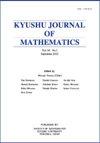第五次painlevÉ超越的椭圆渐近表示
IF 0.6
4区 数学
Q3 MATHEMATICS
引用次数: 4
摘要
对于第五个Painleve超验,Jacobi$\mathrm{sn}$-函数的渐近表示是在无穷远点附近沿着一般方向以奶酪状条表示的。它的椭圆主要部分取决于一个积分常数,该积分常数是相移,并由相关等单调变形的单调数据参数化。此外,在一定假设下,误差项也用一个显式渐近公式表示,其前导项用$\mathrm{sn}$-函数和$\vartheta$-函数的积分表示,并包含另一个积分常数。我们从拉格朗日函数的有界性开始,而不是用Brouwer不动点定理来证明Riemann-Hilbert问题渐近解的正当性,这使我们能够确定满足Bouroux方程的$\mathrm{sn}$函数的模,并推导地构造椭圆表示。本文章由计算机程序翻译,如有差异,请以英文原文为准。
ELLIPTIC ASYMPTOTIC REPRESENTATION OF THE FIFTH PAINLEVÉ TRANSCENDENTS
For the fifth Painleve transcendents an asymptotic representation by the Jacobi $\mathrm{sn}$-function is presented in cheese-like strips along generic directions near the point at infinity. Its elliptic main part depends on a single integration constant, which is the phase shift and is parametrised by monodromy data for the associated isomonodromy deformation. In addition, under a certain supposition, the error term is also expressed by an explicit asymptotic formula, whose leading term is written in terms of integrals of the $\mathrm{sn}$-function and the $\vartheta$-function, and contains the other integration constant. Instead of the justification scheme for asymptotic solutions of Riemann-Hilbert problems by the Brouwer fixed point theorem, we begin with a boundedness property of a Lagrangian function, which enables us to determine the modulus of the $\mathrm{sn}$-function satisfying the Boutroux equations and to construct deductively the elliptic representation.
求助全文
通过发布文献求助,成功后即可免费获取论文全文。
去求助
来源期刊
CiteScore
0.80
自引率
0.00%
发文量
10
审稿时长
>12 weeks
期刊介绍:
The Kyushu Journal of Mathematics is an academic journal in mathematics, published by the Faculty of Mathematics at Kyushu University since 1941. It publishes selected research papers in pure and applied mathematics. One volume, published each year, consists of two issues, approximately 20 articles and 400 pages in total.
More than 500 copies of the journal are distributed through exchange contracts between mathematical journals, and available at many universities, institutes and libraries around the world. The on-line version of the journal is published at "Jstage" (an aggregator for e-journals), where all the articles published by the journal since 1995 are accessible freely through the Internet.

 求助内容:
求助内容: 应助结果提醒方式:
应助结果提醒方式:


